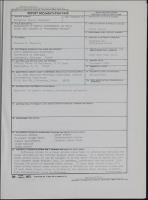Please use this identifier to cite or link to this item:
https://hdl.handle.net/11681/12798| Title: | Evaluation of sample disturbance on soils using the concept of "reference strain" |
| Authors: | University of Kentucky. Department of Civil Engineering Drnevich, Vincent P. |
| Keywords: | Reference strain Resonant column tests Sample disturbance Shear modulus Shear strain Shear stress Stress-strain curves Triaxial shear tests Soils Shear strength Strains Stresses |
| Publisher: | Geotechnical Laboratory (U.S.) Engineer Research and Development Center (U.S.) |
| Series/Report no.: | Technical report (U.S. Army Engineer Waterways Experiment Station) ; GL-79-13. |
| Description: | Technical Report Abstract: Reference strain is a shear strain that is obtained by dividing the shear strength by the initial tangent shear modulus. On a shear stress versus a shear strain plot, it can be thought of as the shear strain at which the initial tangent shear modulus line, if extended, intersects the horizontal line through the point of maximum shear stress. If each shear strain value of a shear stress versus shear strain curve is divided by the reference strain and if each shear stress value is divided by the maximum shear stress, a normalized stress-strain curve is obtained. For laboratory tests where undrained conditions exist or for other loadings such as in triaxial tests , it is possible to adjust the stress- strain data obtained on the basis of the type of loading and the effective stress path to obtain an equivalent, drained, normalized shear stress versus normalized shear strain curve. Resonant column tests can cost accurately measure the initial tangent shear modulus. An ultra sensitive, quasistatic torsional simple shear apparatus also can be used. It gives essentially the same values of initial tangent shear modulus on a given soil as does the resonant column apparatus which indicates that the initial tangent shear modulus is insensitive to strain rate. Extensive testing of a variety of normally consolidated or near normally consolidated, cohesive soils in this study shows that the initial tangent shear modulus is quite sensitive to sample disturbance, mean effective confining stress, and time in secondary compression. Results of torsional simple shear tests and of triaxial compression tests give essentially the same normalized shear stress versus normalized shear strain curve. Use of reference strain provides normalized stress-strain curves which are independent of sample disturbance. These normalized curves may be used to establish in situ stress-strain behavior by making use of initinl tangent shear moduli obtained in the field from seismic tests and by using undrained shear strengths (only needed for undrained field loading conditons) obtained by conventional field tests. This procedure utilizes the "sense" "of the soil behavior from the nomalized laboratory curve, and the "magnitude" of the behavior is obtained from field measurements. |
| Rights: | Approved for public release; distribution is unlimited. |
| URI: | http://hdl.handle.net/11681/12798 |
| Appears in Collections: | Technical Report |
Files in This Item:
| File | Description | Size | Format | |
|---|---|---|---|---|
| TR-GL-79-13.pdf | 13.1 MB | Adobe PDF |  View/Open |